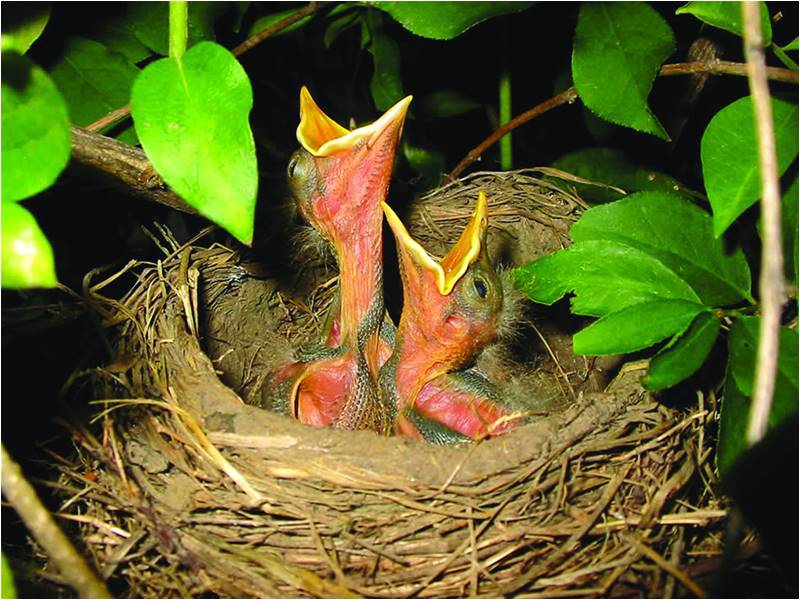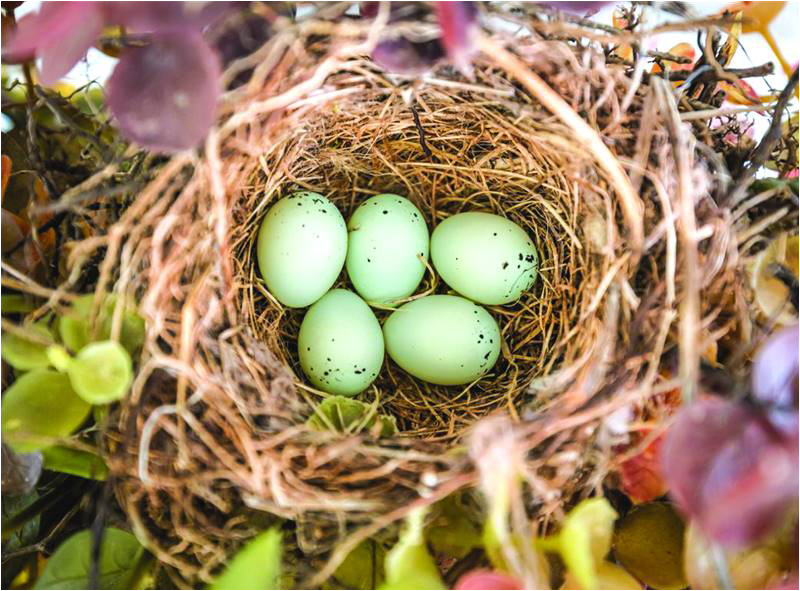
We humans live in a separate and parallel universe from other living beings. Or at least we think we do. It is not often that we get an opportunity to peek into the lives of animals that surround us and which are so much part of the world that we share. Though we humans have staked out our space with sharply demarcated physical and psychological boundaries, our respective worlds do occasionally overlap.
Some years ago I found myself drawn into the life of a bird.
A finch, to be precise.
There is a patch of forest in the back of our house. Luxuriant growth of tall witch hazel, maple, and ash trees provides a thick canopy of cool, comfortable shade in the summer. The thick foliage also provides a measure of safety and security to the inhabitants of the forest and insulates it from the wanton noise pollution that is so much part of our urban living. Secluded in this small world, I sit on a chair on the deck and observe the comings and goings of God’s creatures into this secluded, off-the-trodden-path world. Seasons change as surely as the sun rises every day, and animals – small critters and birds – adapt to the changing seasons. When I am in the woods, I am not merely an observer or an intruder but an integral part, even if a very tiny part, of the whole.

Every year, various birds with their colourful costumes and their happy songs come to the forest and roost in the trees. Some of them drop temporary anchors and build their nests. The cacophony of their songs, the crescendo and decrescendo chirping of the invisible crickets and cicada and almost silent scurrying of the squirrels, raccoons, rabbits and moles add to the visual and audible symphony. Here and there a butterfly enters the woods, flapping its colourful wings to create fleeting rainbows in the backdrop of a lush green landscape.
A pair of finches was fond of a basket of geraniums hung from a tree leaning close to the deck. I observed their frequent visits to the flower basket but did not pay any attention to it. Those birds, I thought, must like red flowers.
Then a thunderstorm passed through our area. It brought in its wake torrential rain and drenched everything in sight, including the flower basket. The sudden heavy rain caused the little creek at the other end of the forest to overflow its banks, an unusual thing this time of the year. The rain also revealed the reason why the birds were so fond of the flower basket. Two tiny chicks, featherless and featureless pink-blobs with oversized beaks and eyes-closed-shut, emerged from the gooey mess in the flower basket and landed on the deck. They were too young and weak to walk, let alone fly. Their feeble voices were drowned in the torrential, noisy rain. Their mother was also caught in the whirlwind of the passing storm and took shelter somewhere. By the time I made an effort through the pouring rain to rescue the chicks, the wind and water had swept them off the deck onto the forest floor 20 feet below. They were not to be seen again.
The mother appeared soon thereafter and went straight to the flower basket. All she found was a water-soaked basket with a crumbling nest. She became frantic when she found no trace of her chicks in the basket. She went from basket to railing calling them. She persisted flying between the basket, the railing, and the woods screaming her heart out. But to no avail.
For two days she kept the vigil. For brief periods, she would leave the woods but upon her return she would start looking again. As time passed, her sharp and shrill cries gave way to what sounded like the subdued songs of loss and lament. Gone was the frantic search for her chicks. She would fly from tree to tree, bush to bush, and sing her mournful songs. It was not hard to feel her pain and anguish.
The birds are no different than us when it comes to losing our dear ones. I saw a parallel between the helplessness of the lonely bird and people who are in helpless in similar situations. Like the desperate bird, I, too, have experienced the emptiness on the sudden loss of my dear ones. The agony and torment is no different. The inborn urge to protect and preserve one’s progeny is the same and the way we face life-threatening situations is the same. Our mutually exclusive parallel universes do overlap.
That particular storm did pass, as all storms do, and the sun rose again, as it always does. The emptiness that the bird experienced and helped me understand, would eventually be filled by other life beginnings, as it always is.
The little bird has now left for some other patch of woods where she will build a new nest, mate, lay eggs, and nest them until they hatch. She will nurture her chicks, give them wings, and see them fly off to start a new life cycle of their own.
In the meantime, I have placed the hanging basket under the overhang to protect it from unexpected rain. Just in case.
Dr. Sayed Amjad Hussain holds Emeritus professorships in Humanities and cardiovascular surgery at the University of Toledo, USA. He is also an op-ed columnist for Toledo Blade and daily Aaj of Peshawar.
Contact: aghaji@bex.net
Some years ago I found myself drawn into the life of a bird.
A finch, to be precise.
There is a patch of forest in the back of our house. Luxuriant growth of tall witch hazel, maple, and ash trees provides a thick canopy of cool, comfortable shade in the summer. The thick foliage also provides a measure of safety and security to the inhabitants of the forest and insulates it from the wanton noise pollution that is so much part of our urban living. Secluded in this small world, I sit on a chair on the deck and observe the comings and goings of God’s creatures into this secluded, off-the-trodden-path world. Seasons change as surely as the sun rises every day, and animals – small critters and birds – adapt to the changing seasons. When I am in the woods, I am not merely an observer or an intruder but an integral part, even if a very tiny part, of the whole.

Every year, various birds with their colourful costumes and their happy songs come to the forest and roost in the trees. Some of them drop temporary anchors and build their nests. The cacophony of their songs, the crescendo and decrescendo chirping of the invisible crickets and cicada and almost silent scurrying of the squirrels, raccoons, rabbits and moles add to the visual and audible symphony. Here and there a butterfly enters the woods, flapping its colourful wings to create fleeting rainbows in the backdrop of a lush green landscape.
A pair of finches was fond of a basket of geraniums hung from a tree leaning close to the deck. I observed their frequent visits to the flower basket but did not pay any attention to it. Those birds, I thought, must like red flowers.
Then a thunderstorm passed through our area. It brought in its wake torrential rain and drenched everything in sight, including the flower basket. The sudden heavy rain caused the little creek at the other end of the forest to overflow its banks, an unusual thing this time of the year. The rain also revealed the reason why the birds were so fond of the flower basket. Two tiny chicks, featherless and featureless pink-blobs with oversized beaks and eyes-closed-shut, emerged from the gooey mess in the flower basket and landed on the deck. They were too young and weak to walk, let alone fly. Their feeble voices were drowned in the torrential, noisy rain. Their mother was also caught in the whirlwind of the passing storm and took shelter somewhere. By the time I made an effort through the pouring rain to rescue the chicks, the wind and water had swept them off the deck onto the forest floor 20 feet below. They were not to be seen again.
The mother appeared soon thereafter and went straight to the flower basket. All she found was a water-soaked basket with a crumbling nest. She became frantic when she found no trace of her chicks in the basket. She went from basket to railing calling them. She persisted flying between the basket, the railing, and the woods screaming her heart out. But to no avail.
For two days she kept the vigil. For brief periods, she would leave the woods but upon her return she would start looking again. As time passed, her sharp and shrill cries gave way to what sounded like the subdued songs of loss and lament. Gone was the frantic search for her chicks. She would fly from tree to tree, bush to bush, and sing her mournful songs. It was not hard to feel her pain and anguish.
The birds are no different than us when it comes to losing our dear ones. I saw a parallel between the helplessness of the lonely bird and people who are in helpless in similar situations. Like the desperate bird, I, too, have experienced the emptiness on the sudden loss of my dear ones. The agony and torment is no different. The inborn urge to protect and preserve one’s progeny is the same and the way we face life-threatening situations is the same. Our mutually exclusive parallel universes do overlap.
That particular storm did pass, as all storms do, and the sun rose again, as it always does. The emptiness that the bird experienced and helped me understand, would eventually be filled by other life beginnings, as it always is.
The little bird has now left for some other patch of woods where she will build a new nest, mate, lay eggs, and nest them until they hatch. She will nurture her chicks, give them wings, and see them fly off to start a new life cycle of their own.
In the meantime, I have placed the hanging basket under the overhang to protect it from unexpected rain. Just in case.
Dr. Sayed Amjad Hussain holds Emeritus professorships in Humanities and cardiovascular surgery at the University of Toledo, USA. He is also an op-ed columnist for Toledo Blade and daily Aaj of Peshawar.
Contact: aghaji@bex.net

